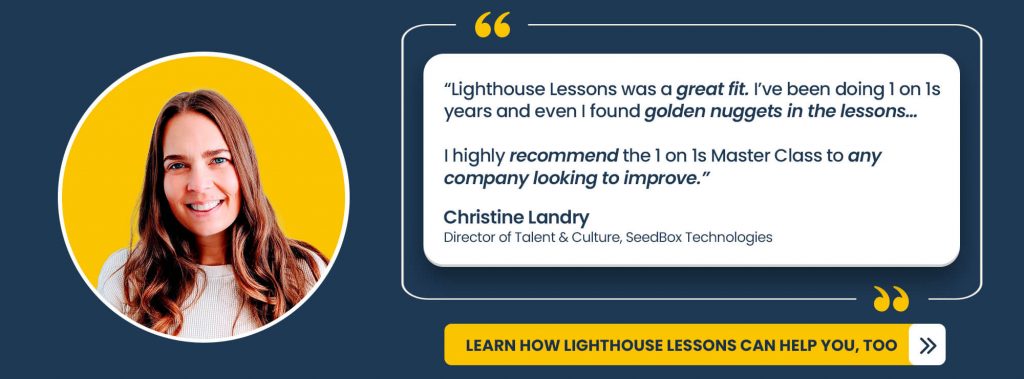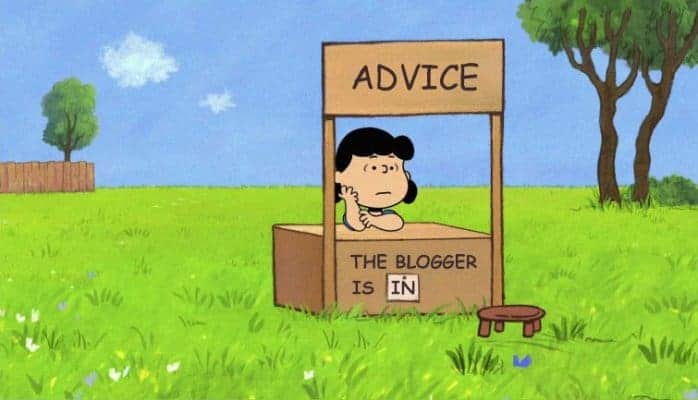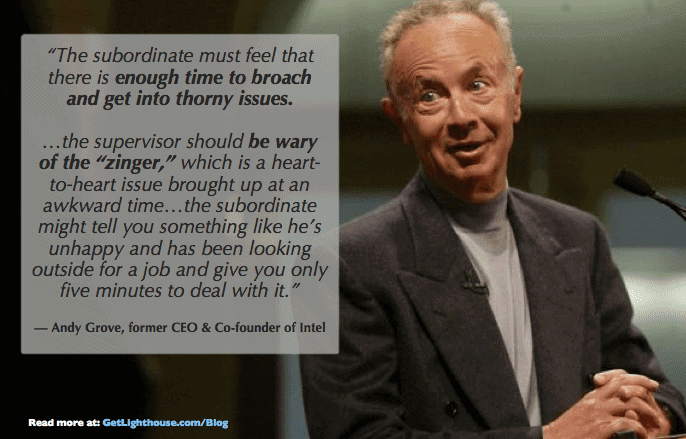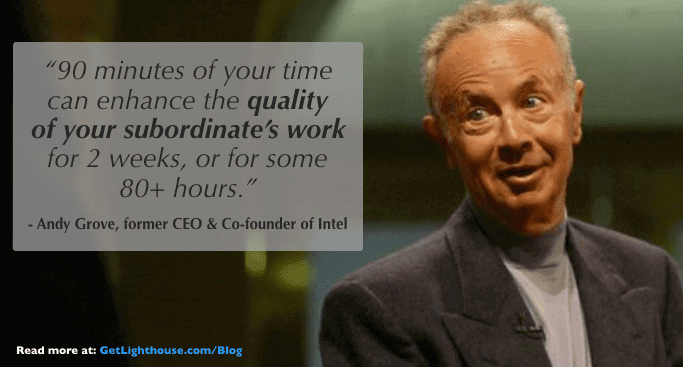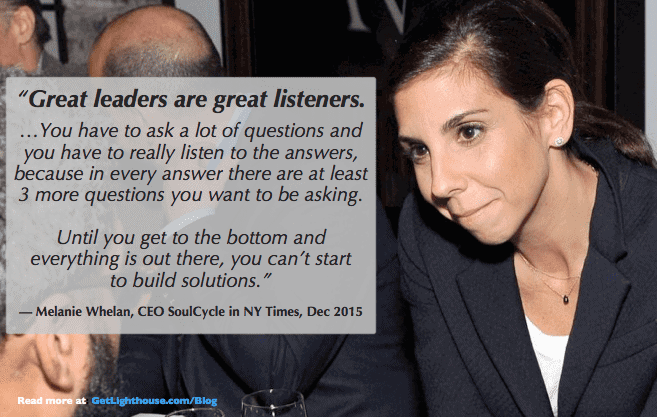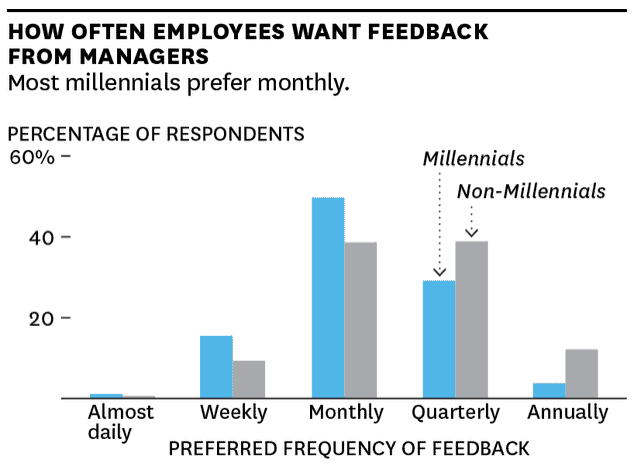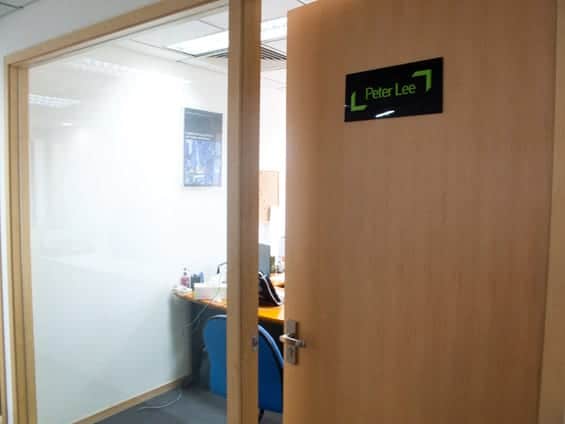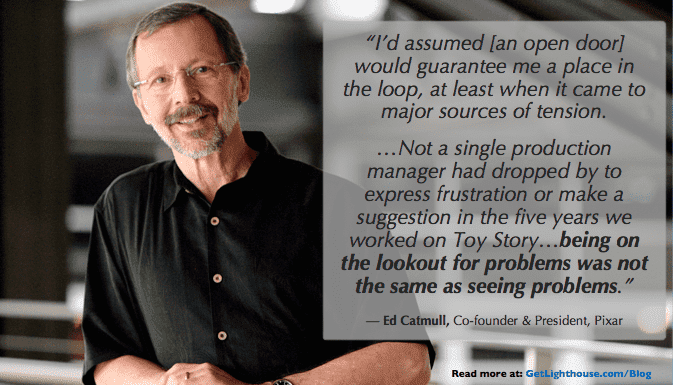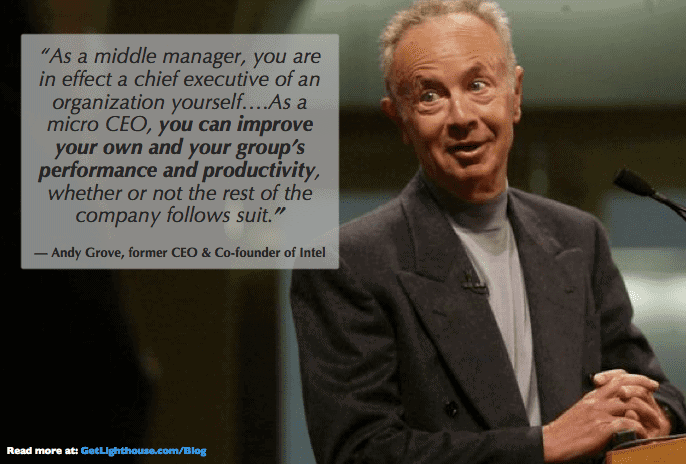1:1s are an essential habit for high performing teams. Many good leaders and companies swear by them.
However, just because you're meeting with your team 1:1 does not guarantee great results. You have to make the most of the time, and avoid the many pitfalls you can fall into in them.
Not all advice is created equal.
One of the challenges in today's world is that anyone can start a blog, and so can any company. Throw together a few link roundups and tips and you're on your way. Unfortunately, many of them write bad content and give mediocre or poor advice, actually hurting their customers and readers.
Here at Lighthouse, we take the advice and content we write very seriously. Every post is filled with citations and sources, as well as research and best practices. If we haven't seen it work in real life, understand *why* it worked, and have some best practice or research we can cite, we don't write about it.
Unfortunately, a lot of companies don't have these high standards. They hire an intern or a contractor to crank out some content and if it has a catchy title or hits a word count requirement, they post it. They might quote or link to a few other posts begging for a tweet from the original source, but it's rarely done with any goal except hoping for a share.
We work hard to bring you helpful insights, original ideas, and best practices. There are only a few things we'd call ourselves experts on, and 1:1s is definitely one of them. So today we'd like to dispel some of those bad pieces of advice to help you make the most of your 1:1s.
The Worst Advice on 1:1s (and what to do instead)
The beauty of 1:1s is how flexible they are; you can use them for so many different purposes. However, this flexibility is also part of the challenge: with so many approaches, you can easily be missing out on better approaches, and results.
The approaches and advice below all comes from real companies and blogs. The names, companies, and sites are not cited to protect the innocent. The goal is focusing on dispelling the bad advice.
Let's dive in.
Bad Advice #1: Run your 1:1s with the 10/10/10 Rule
It sounds so clean and simple: 10 minutes for you, 10 minutes for me, and 10 minutes for the future.
But what is that really saying? You're giving your team member *10 minutes* to bring up everything important to them.
How can anyone ever hope to tackle anything meaty in that amount of time? You can't.
And that's the biggest flaw. While structure for meetings is nice, when it prevents you from bringing up important topics, it ruins the the purpose of 1:1s.
Learn from a legend.
Andy Grove, who co-founded Intel and built it to a $20 billion company, was a huge fan of 1:1s, as the quote above shows.
He devoted an entire section of his legendary management book, High Output Management, to the subject as well. He felt that investing significant time into the meetings was critical as he wrote:
"The subordinate must feel that there is enough time to broach and get into thorny issues.
Look at it this way. If you had a big problem that you wanted to kick around with your supervisor – the person whose professional interest in the matter is second only to yours – would you want to bring it up in a meeting scheduled to last only fifteen minutes? You would not."
All the efficiency you save from following the 10/10/10 rule is a minor benefit compared to what you miss out on because you compress the time to tackle issues with them.
What to do instead: Be flexible with how much time you spend on an issue in your 1:1s. Don't make your team feel boxed into just 10 minutes. If possible, set aside a full hour; it's easier to end early than it is to get nailed with a zinger right as you're getting a notification for your next meeting to run to.
Still not sure? Read more about why the 10/10/10 rule is for mediocre managers here.
Bad Advice #2: One on ones once a month is enough for everyone on your team
In an average month, there are 20 work days and at least 160 hours of work. There are countless meetings, interactions with colleagues, and challenges people face. Professional and personal issues can rise, fall, and explode in that time.
The only way to avoid getting trapped in reactive management, is to fix problems when they're small. But you cannot do that if you don't hear about problems in that state.
Your 1:1s are one of the best times to hear about problems early, because it's a safe, private environment. If you wait for them to come to you explicitly outside a scheduled time, they're much more likely to have already become big problems.
If you only meet with your people once a month, there's too much that can happen between your meetings.
You don't know what you're missing.
While meeting once a month for your 1:1s may feel nice on your calendar, you're setting up you and your team to miss out on valuable conversations:
- New Hires: A lot can happen in a month. Are you sufficiently helping a new team member feel welcome, productive, and supported?
- New Responsibility: Are you adequately supporting a team member who has a new role or responsibility? Also known as a change in their Task Relevant Maturity, many new questions will come because of it.
- More Topics: Meeting only once a month gives you less time to cover the wide variety of topics you can cover in your 1:1s (like career goals, coaching, feedback, praise, floating ideas, etc).
This also ignores the procrastination and lack of urgency meeting monthly creates. When you have a month to do something, it's easy to let it slip. If you were meeting again in a week or two, you'd be much more likely to take care of it quickly.
What to do instead: Have your 1:1s every week or two with everyone on your team. If you have a massive team (10+), then prioritize those who are new to a role or your team to meet more often. If you've worked with someone for years, and they're very good at their job, it's safer to meet less often so you can invest more in others.
Still not sure? Read more about why once a month is not enough here, and learn about the critical management concept, Task Relevant Maturity here.
Bad Advice #3: Talk about projects and status updates the whole time
Despite one major HR tech company's suggestion, the 1:1 is not for managers to get status updates from their teams. That's a huge waste.
There are a variety of ways to get status updates that don't eat up this one time to talk about things important to your team member: email, standups, checking your project management tool, asking in your chat app, etc.
Not only are status updates better suited for other mediums, they rob you of the value of your 1:1s. If you're talking about projects, tasks, and the stuff that fills your team's other 39-59+ hours per week of work, then you'll never have time to talk about all the awesome things you should be covering in your one on ones like:
- Coaching them and giving helpful feedback.
- Helping them grow and discussing their career goals.
- Getting their feedback, suggestions and ideas.
- Floating ideas, getting buy in, and testing the waters on big changes.
- Talking through people and team issues.
- Giving them the chance to talk about what's on their mind.
If you don't talk about those things in their 1:1s, when will you?
What to do instead: If you typically spend a lot (or all) of your 1:1s talking about project statuses, try asking your team for them the day before your 1:1s instead. Then, bring up some of these other topics in their 1:1s. You may be surprised how much better the meeting goes and the value you get from these other discussions.
Bad Advice #4: It's the team member's meeting so you don't need to bring anything
I've seen a number of managers confidently say (and sometimes tweet it) about their 1:1s: "It's my team member's meeting, so if they don't have an agenda, I cancel it."
That's a huge mistake.
Whether your team has an agenda full of items they want to discuss or not, you as their manager should be preparing for the 1:1 as well. That means thinking about topics you want to discuss, bringing feedback to them, and the variety of other topics we just talked about in #3.
Bring good questions.
One of the best skills you can develop as a manager is curiosity. Learning to ask good questions helps you get to the root cause of issues, and avoid jumping to conclusions.
When you're in 1:1s with your team, it's one of the most critical times to be asking questions. As entrepreneur and investor Ben Horowitz has written, this is especially important for introverts, who you will often have to work to draw things out of.
What to do instead: If your team brings topics to discuss, having good followup questions to ask is key to fully understanding a situation. If they don't bring anything, having questions ready to discuss anyways can make for a very productive meeting.
Remember: Not every person on your team has the same experience you have had with 1:1s. All too often, employees have no idea what a great one on one is like, so they don't even know which topics are safe to bring up.
If you bring a wide variety of questions to your 1:1s, you'll be showing them those topics. Over time, you might just find they start bringing more now that they know what's fair game.
Still not sure? Here's a comprehensive look at everything that goes into an effective one on one according to some of the best leaders and management experts.
Bad Advice #5: Every 1:1 meeting should be the same
The sister of the status update 1:1 is the 1:1 that is identical every time. If all you do is go over the exact same things, or the same questions, there's likely a lot going unsaid.
The most common version of the repetitive 1:1 is one focused on the same 3 types of questions:
- How is Project X going?
- Do you have any blockers?
- How can I help?
There's nothing wrong with those questions in isolation. The problem becomes when that's all you talk about.
"Variety is the spice of life."
When you mix up the topics of discussion in your 1:1s, you experience a variety of benefits:
- New insights: When the topics & questions are different, the discussions & insights will be as well.
- Improved relationships: When you mix in time to build rapport by getting to know them a little personally, you may be surprised how that improves your working relationship.
- Enjoyable meetings: When the topics change, and expand into more healthy discussions, you have more reason to look forward to the meeting. You also avoid the monotony often associated with repetitive ones.
What to do instead: If you have a 1-1 meeting template you use, consider mixing it up and adding to it. What can you ask this time that you didn't talk about last time? Have you talked about their career or given any feedback lately? You may be surprised how much energy and enthusiasm some small changes can bring.
Still not sure? Here one on one meeting questions that will come in handy.
Bad Advice #6: Quarterly check ins are effective
I really feel for the woman in the image above. This was used for a guest post on an HR blog where a certain HR company claimed quarterly check-ins are both common and effective. In fact, neither are true.
Ignoring the fact that there are 2 people across the table from this woman (making it by definition, not a 1:1), if my manager only wanted to "check-in" once every 3 months with me, I would also look sad, dejected, and frustrated.
Too much happens in a quarter.
We talked earlier about how so much can happen in a month, and it's only compounded when you consider what happens in three months. At that rate, there is a minimum of over 500 hours of work between times a manager is checking in with their team.
What does it say to your people when you feel that less than 0.2% of their work time is worth having discussions about things important to them?
As just one example, most people, regardless of generation, want more feedback than once a quarter (one of many good topics for your 1:1s):
Equally important, someone who is frustrated could lose hope, start interviewing, secure a job, and give their notice between times you check in with them.
What to do instead: As discussed above, try to meet with your team members each every week or two. If your team is massive (10+) you can be flexible with those you trust and know best, but no one should go more than a month.
Still not sure? We have a complete post focused on why quarterly check ins don't work and cause turnover here.
Bad Advice #7: An open door policy works instead
It sounds so friendly, "my door is always open." But is your door really "open"?
In today's workplace that's not always easy to tell:
- If you're in meetings all day, they can't stop by to talk to you.
- If you're in an open office environment, how do they approach you about a sensitive subject?
- If they're remote, how do they know if your door is open?
- If they're remote, what do they do if there's limited hours of overlap in your work hours?
Even worse, even in situations where people are in the office with you, and you have an office, it rarely works. Ed Catmull, cofounder and President of animation giant Pixar learned this the hard way:
Problems don't come to you. You have to find them.
As Catmull describes so well, people aren't likely to walk in and tell you about problems via your open door policy.
In the case of the situation he recalls in his excellent leadership book, Creativity, Inc, there were major problems hidden beneath the surface as they made Toy Story. Yet, the group of staff members affected quietly suffered through it for five years.
After learning about it finally after the fact, he changed his ways and started to seek out issues and go talk to people 1:1.
Catmull is not alone.
In Camille Fournier's new book, The Manager's Path, filled with advice for engineers rising in management roles, the former CTO writes:
"The open-door policy is nice in theory, but it takes an extremely brave engineer to willingly take the risk of going to her boss (or especially her boss's boss, etc) to tell him about problems. That even assumes that the engineer knows what the problems actually are well enough to explain them!
...The risk of relying on an open-door policy increases the further away you get from a team. This culminates in the most classic, clueless executive move of relying on office hours instead of meeting one-on-one and with teams directly, and wondering why the wonderful management staff isn't managing to retain great talent or get things done...you won't ever see these issues if you never take the time to look."
Isn't it interesting how similar the lessons Fournier and Catmull learned are despite being in very different industries?
What to do instead: As Fournier suggests, make the time to meet with key people 1 on 1 and with teams that are below you in your hierarchy. Never underestimate the value of peer one on ones and skip level one on ones.
Still not sure? Here's a full essay just on the failings of open door policies and what to do instead.
Bad Advice #9: 1:1s are just mini-reviews
One of the big trends in HR in recent years is getting rid of performance reviews. Some very well known companies like Deloitte, Accenture, GE, and Adobe have all taken the leap and replaced reviews with regular 1:1s.
The mistake companies make emulating these industry leaders is thinking that 1:1s are just a whole bunch of mini-reviews throughout the year.
1:1s are a different way of doing things
Performance reviews are pretty universally despised. Good 1:1s are generally loved. That's because the former is usually for the company: who gets a raise or promotion, who is fired, or put on PIPs. Meanwhile, as Andy Grove says, 1:1s are about what's most important to your team members.
What's on a performance review should never be a surprise. You should talk about issues and provide feedback throughout the year. These are great topics for your 1:1s. However, there's an important difference between reviews and 1:1 feedback; reviews are evaluating someone. 1:1 feedback is about coaching them.
When you make your 1:1s into mini-reviews, you set yourself up to make the meetings something you both don't look forward to. It's a lot of work to write a review, and a lot of emotional baggage. You also box out other great topics to discuss we've covered earlier.
What to do instead: Whether you keep your reviews or not, don't make 1:1s into mini-reviews. Instead, focus on the variety of great topics we've talked about in earlier sections. You may be surprised how much your team appreciates this kind of quality time with you and how much better you then get along with your team.
Still not sure? Learn more about how Adobe, GE, and Deloitte got rid of reviews with one on ones here.
It's up to you to make your 1:1s awesome.
Regardless of what's happening in your company, you can make the 1:1s you have with your team great. Remember a few of the keys we discussed today:
- Weekly or Biweekly: Have them at a frequency where you can get real value from them.
- Prepare Questions: Bring some questions to ask and use the time in the 1:1s to ask good followups.
- Expand the Topics: Coach them, give and receive feedback, talk about their career, float ideas, and build rapport.
- Make Time for Them: Give yourself enough time to get into meaty topics. 30-60 minutes, without a time constraint on what they want to discuss is best.
Are you and your managers wasting their 1 on 1s?
There is no greater investment to make in your team than having 1 on 1s. Yet, done poorly they’re a huge waste of time.
That’s why we made the 1 on 1 Master Class. You and your fellow managers learn step by step how to supercharge these meetings to motivate your teams, fix problems, coach your people, and much more.
You can learn how Lighthouse Lessons can help your leaders like we helped SeedBox Technologies by signing up here.
